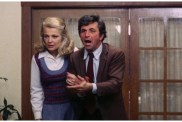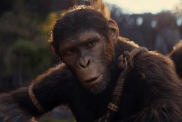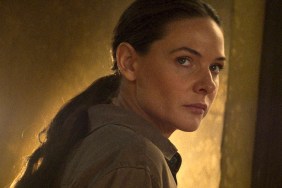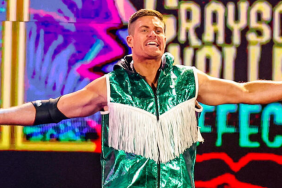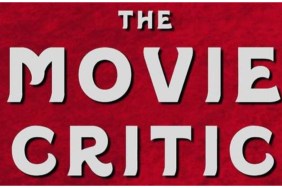Descent director talks gory action epic

Taking a departure from the creature feature fare that put him on the horror map, writer-director Neil Marshall flexes his muscles and unloads with both barrels in the post-apocalyptic action film Doomsday (opening from Rogue Pictures on March 14th).
Starring Rhona Mitra, Bob Hoskins, Malcolm McDowell and Craig Conway, Marshall’s third feature endeavor – his first “studio” film – picks up in a virus-ravaged Britain where there’s unrest amongst the quarantined survivors and the possibility of a cure for the deadly Reaper strain which has forced officials to build a wall around Scotland. Doomsday represents not only Marshall’s range, but his push to Hollywood’s frontlines where all eyes will be on him as Rogue unleashes the film on an estimated 1,800 screens across the country. Shock initially spoke to Marshall last summer at Comic-Con. Time was limited and we promised to continue our chat later down the road. The following is a phone interview that picked up where we left off.
ShockTillYouDrop.com: You’ve gone through the testing process now – how did it go?
Neil Marshall: The testing went fine. I think we got a better reaction on the West Coast than we did on the East Coast. But good reactions all around. It’s part of the process that’s a love/hate relationship I have with it. I understand the need for it and it sometimes offers good responses, but in some ways I still kind’ve hate it.
Shock: To be honest, I recently caught “The Descent” on cable and it was the first time I saw the U.S. conclusion which was ultimately the result of a test screening.
Marshall: They had tested it with the UK ending and then with the U.S. ending and the latter tested higher which was why they asked if we could cut it. We only agreed to cut it on the basis that they were going to give us a wide release. From my point of view, I got what I wanted which was to get a maximum release and I knew that the other ending was going to be seen on the uncut DVD anyway.
Shock: When we sat down for breakfast at Comic-Con last summer, we discussed the origins of “Doomsday” but didn’t have time to delve into the specific of the production. Then, you had told us the idea had been gestating for a few years – was a script you penned then revisited while working on “Dog Soldiers” and “The Descent”?
Marshall: Up until I had started writing the film for Rogue, it was a five-page treatment and yes, I had gone back to rewrite it and refined it as best I could. It was only two and a half years ago that Rogue stepped in and commissioned a script based on that.

Shock: How did the story change along the way? Did you find yourself scrapping a lot? Making major additions?
Marshall: Yeah, it definitely evolved. Certain sequences had to be dropped along the way because they were too big and too expensive. We had a sequence of helicopter gunships attacking this medieval castle at one point and I very quickly realized it would be stretching the budget way too thin. I’ll save that for the sequel. [laughs]
Shock: Was having a female protagonist always the plan?
Marshall: When I first came up with the idea six years ago, I always intended to have a strong female lead. At the time I didn’t know it was going to be the film I did straight after “The Descent” so it was just a coincidence that I’d end up doing two films back-to-back about strong female leads. I don’t see any problem with that, it’s just a question of character – man or woman, it doesn’t matter.
Shock: Because screenings are all but nil to us press folk, can you elaborate on who Rhona Mitra plays?
Marshall: Rhona plays Major Eden Sinclair who is a very highly respected and dangerous police officer – the army and the police have been amalgamated into one thing because Britain has been isolated so there’s no need to have an army any more because of this virus outbreak. She’s a Major in this division called the DDS, the Department of Domestic Security. Her boss is played by Bob Hoskins who is this cop who remembers the old days. He’s her boss and her father figure, the only guy who can talk to her without getting a kick in the bollocks from her.
Shock: You’ve populated those who have been quarantined in Britain with an impressive cast, too.
Marshall: The team Sinclair goes into Scotland with is made up of soldiers and scientists. The scientists are played by Sean Pertwee and Darren Morfitt from “Dog Soldiers.” The soldiers are Chris Robson, also of “Dog Soldiers,” and Nora-Jane Noone of “The Descent.” They all go up over this wall and into a world presided over my Malcolm McDowell, a scientist who got trapped behind the wall during the quarantine. His son, a character named Sol, played by Craig Conway and he’s at war with his father. And these two tribes are at battle.
Shock: I didn’t realize there was a sub-plot with that level of in-fighting!
Marshall: [laughs] Yeah, Sinclair basically stumbles into a war with rival factions.
Shock: Casting Mitra – did you envision her as Sinclair from the start? How did she step up to your expectations?
Marshall: She really stepped up to the role. She was down in South Africa for eleven weeks doing stunt and fight training beforehand. It was a difficult part to cast because they’ve got to be British. She had to look tough and look the part. She fits the profile brilliantly.
Shock: And her counterpart, Bob Hoskins?
Marshall: I was always looking for Bob for that particular role. I was looking for the Bob from “Long Good Friday” and not Bob from “Who Framed Roger Rabbit?” [laughs] The hard Bob.

Shock: How did you go in mentally preparing for something this grand. There’s a publicity still of you in the foreground with a helicopter in the background and you look like a kid in a candy store…
Marshall: It was brilliant, it was such a relief to not be constrained. The whole thing about “The Descent” was constraint. Squeezing cameras into tight spaces and all of this stuff. Here I just got to spread my wings and fly. I was a little bit daunted by the scale of it at first, but at the end of the day, it’s exactly the same process, just bigger numbers. I lapped it up. By the end of the shoot, the bigger the scene the better, the bigger the action sequence, the more logistically complicated, the more I got into the whole thing.
Shock: That said, what aspect really made the fanboy in you leap out. As a director you supervise everything, so was it weapon design, car design, action set-pieces…
Marshall: Everything… I loved it all. We built cars – we built these armored personnel carriers from scratch – we had weapons that were amazing. Built hundreds and hundreds of them all down in South Africa, these primitive weapons. Clubs and spikes, chainsaws that you strap to your arm, changing a hedge trimmer by putting a circular saw blade on the end – there was a lot we did and our departments had a lot of fun. And the locations were simply spectacular, I was looking for the most cinematic locations possible. I just sort’ve thrive on the whole process and love being around people who are coming at me with questions 24/7 and I have to provide them answers. You just have to be quick and decisive.
Shock: Sounds smooth, but on the flipside of that, was there anything that didn’t work out due to being too complex?
Marshall: Nothing really. I thought the weather was going to be a problem because we had to go to Scotland for the last week of the shoot. We were going from the blazing sun of South Africa to the soggy weather of Scotland. But we had blazing sunshine for a week. What I had on this was a helluva lot more toys to play with from cranes, to FX, to stunt guys, I didn’t have to compromise on anything.

Shock: George Miller’s “Road Warrior” world was an obvious influence, as we discussed, but how do you put your own stamp on something like this, transcend the comparisons?
Marshall: It’s a question of using things as a starting point, a blueprint. The comparisons are unavoidable because you’re dealing with a future world about scavengers, the future tribes have scavenged stuff from our time and utilized it to our needs so there are going to be similarities to a point. But our idea was to twist and turn it and do something fresh and new with it. The car chase is an obvious example. Again, we’ve got a bunch of cars racing along a road and it first appears to look like “Road Warrior.” But what’s going on in the chase is completely different. There is a really intense fight going on within the chase. There’s a battle with the vehicles, a battle going on within the vehicles – it’s really intense and nasty. It goes haywire. I wanted to ramp up things times ten.
Shock: What’s striking – and we see more and more of it in the TV ads – is the image of the knight, which I assume, is armor scavenged by the tribes.
Marshall: Right, you’ve got these people scavenging cities and stuff. In the world of Scotland, the best buildings to take over are castles and museums, so I thought what if they scavenged a museum and stole these suits of armor and have adapted this almost medieval lifestyle. There’s plausibility to it all. The guys in the cities look like scavengers from “Mad Max” but those living in the castles don’t have the supplies, the electricity and are living this barbaric lifestyle. So, “Excalibur” and Terry Gilliam served as inspirations to me. But like I said it had to be plausible.
Shock: The film reunites you with makeup FX artist Paul Hyett whom you worked with on “The Descent” – what was his grocery list of effects work like this time? He once told you that there’s even more violence in this film than in “Descent.”
Marshall: This film doesn’t hold back. Paul said that the gore is spread throughout the entire movie. Looking at the finished film and trying to have an objective view on it, it’s incredibly violent and hardcore. The horror fans are going to appreciate that for sure.

The challenges are the same, so, you’re trying to make the best film possible. For me it’s about the time and the facilities that are at your fingertips. You’re trying to achieve the same goal. Half of me wants to say I’ll take what I can get, but I’d alternate between small scale and large scale films. With the small stuff, you’re not being pressured into getting a name cast, it gives you more freedom as a director. That certainly helps, but that’s not to say I didn’t have a tremendous amount of freedom on “Doomsday.” It was my first studio film and it was amazing. The guys at Rogue were supportive. It’s all a question of the story and the characters for me. I’m seeking to push the envelope as much as possible. With “Descent” and “Dog Soldiers,” I wanted a $3 million movie look like a $10 million movie. With this one I wanted a $28 million movie look like a $60 million movie. Put everything on screen and get the best possible production value out of it.
Shock: How was your dialogue with composer Tyler Bates during post-production since he’s based here in L.A. and your overseas? What kind of feel were you trying to capture with the music?
Marshall: Tyler is so passionate about what he does. It was difficult circumstances given the distances because we’re constantly changing the movie during editing and he’s trying to write the score. He really delivered something diverse and interesting. What I was after was a mix of ’80s synth stuff that sit with the whole post-apocalyptic sort’ve thing, but that doesn’t go well with the intense action of the film. So, we had to find a blend that went from synth to heavy orchestral stuff. He had all of these tricks up his sleeve. I loved it.
Source: Ryan Rotten

